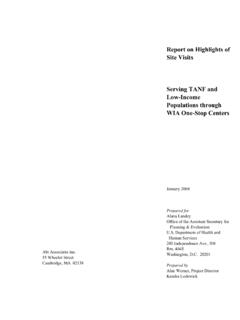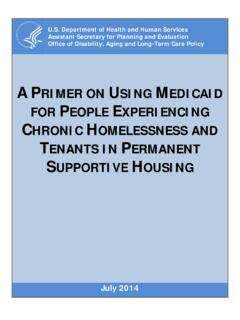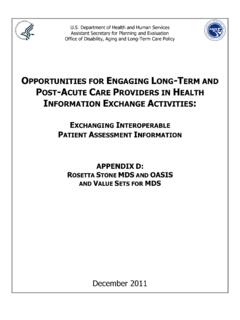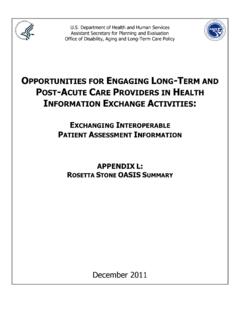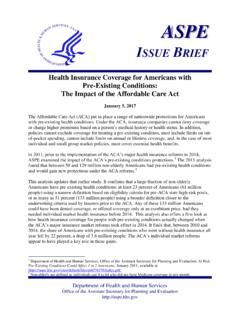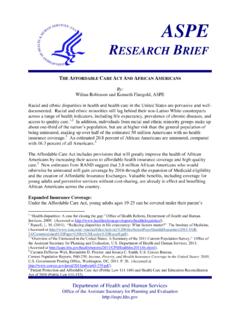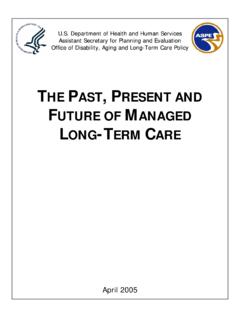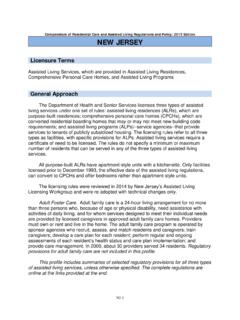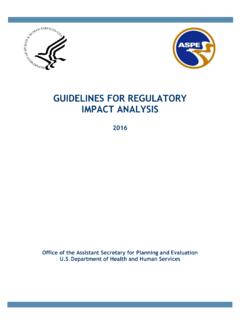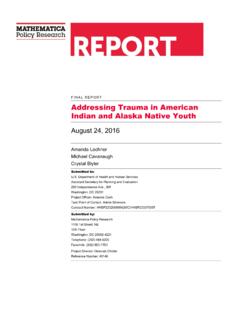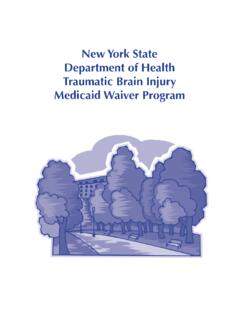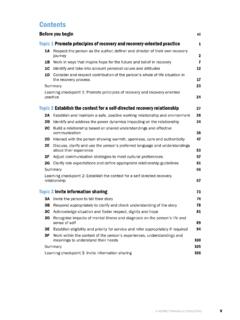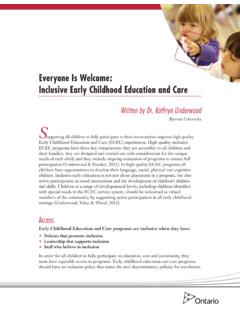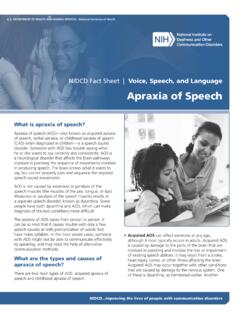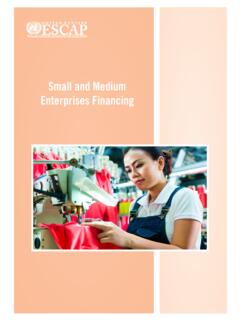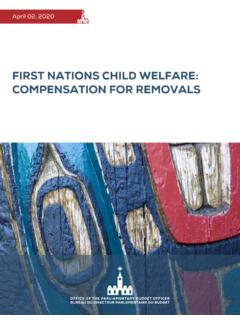Transcription of The Impacts and Implications of COVID-19 on Household …
1 October 2021. Office of the Assistant Secretary for Planning and Evaluation Department of Health and Human Services OFFICE OF HUMAN SERVICES POLICY. The Impacts and Implications of COVID-19 on Household Arrangements Author: Alec Vandenberg _____. KEY FINDINGS. Housing arrangements differ in their composition, the motivation behind their creation, and their effects. The diversity of arrangements contribute to research gaps, particularly in the understanding of how these arrangements affect individual Household members' experiences. Pre-pandemic and emerging data suggest that housing, economic, and social pressures related to the COVID-19 pandemic and associated recession likely increased the number of shared households, influencing resource security, well-being, and COVID-19 transmission and risk. People living in informal and/or doubled-up housing arrangements can represent some of the most economically vulnerable households, yet these individuals and families may face barriers to receiving assistance.
2 Additional research on the experiences of specific populations during the pandemic, as well as analysis of how evolving Household formations affect Household members' economic stability and holistic wellness, can help inform an inclusive economic recovery. _____. Introduction Demographic data indicate that greater numbers of Americans continue to form joint households, many in response to economic pressures and housing According to Census data, the number of shared households, defined as households that include one additional . adult beyond the head of the Household and a spouse or partner, increased from million in 2007 to million in Periods of economic insecurity typically expedite this trend. In the context of the COVID-19 pandemic, additional economic and housing pressures may drive more individuals and families to double up and enter into informal housing arrangements, influencing both economic security and COVID-19 transmission and Intergenerational households often represent a common shared housing arrangement.
3 Starting around 1980, across all major demographic groups, the prevalence of multigenerational family households began to grow again after decreasing after World War II. 4 Social and economic forces, such as the change in median age of first marriage, waves of immigration, and recessions, continue to spur these Pew Research Center analysis of census data indicates that in 2016, a record 64 million people, or 20 percent of the population, lived with multiple generations under one The percentage of population in multigenerational households defined as households including two or more adult generations, or including grandparents and grandchildren younger than 25 has risen from 2009-2016 across all racial and ethnic groups. In 2016, 29 percent of the Asian population lived in a multigenerational Household compared to 27 percent of the Hispanic population, 26 percent of the Black population, and 16 percent of the White population. Population growth and immigration, among other factors, play a role in driving these According to an Association of American Retired Persons pre and mid- COVID-19 pandemic analysis of multigenerational households, cultural nuances also play a role in shaping Household members' motivations and attitudes toward shared The compositions and characteristics of joint households can vary, affecting Household members in a variety of ways.
4 Arrangements can include multiple, distinct families under one roof;. intergenerational households; shared housing; and informal renters living in a basement (see Types of Joint Households Box on next page). Joint Household members may be students returning home from higher education, rent-burdened families moving in together, or elders sharing a roof with their adult children. Doubled-up individuals and families may or may not live as informal renters. The diversity of arrangements and their motivations contribute to research gaps, particularly in the understanding of how these arrangements affect individual Household members' experiences. Knowing the contexts and formations of various households can help programs better understand which arrangements best support participants, how the composition of the Household and how to meaningfully promote equity in resource access and program outcomes. This brief identifies emerging literature on the Impacts and Implications of the covid - 19 pandemic on Household arrangements as well as considerations for how to best serve multiple individuals and families under one roof during the pandemic and in the future.
5 Types of Joint Households Exist on a Spectrum Housing arrangements differ in their composition, the motivation behind their creation, and their effects. The definitions in the box below and in Figure 1 are not comprehensive. They provide one way to visualize the types of households described in the literature along a spectrum. Across each type of housing arrangement, economic insecurity can drive decisions to form a joint Household , Household members may stand at greater risk of COVID-19 exposure,8 and members of multiple generations may be present. Types of Joint Households Doubled-up: Doubled-up households have one or more adults in addition to the head of Household and spouse or partner, such as an adult child living at home, two related or unrelated families residing together, or a parent living with an adult child. Households can be also tripled up. I. Home sharing: A homeowner or lease holder rents out one room or more. Informal renters: Informal housing arrangements include those outside the traditional landlord-tenant relationship, such as roommates and sublessors who pay cash rent and have oral agreements instead of a proper Overcrowding: Often measured by persons per room, the standards used to measure Household crowding continue to be Shared housing: Two or more people live in one permanent rental housing unit, sharing costs such as rent and I.
6 II. III. IV. 2. The literature on joint households uses a wide range of terms, sometimes interchangeably. This brief Some programs consider sharing the identifies a range of housing arrangements and housing of other persons due to loss of highlights the experiences of informal renters and housing, economic hardship, or a similar people living in doubled-up housing. Although joint reason as experiences of homelessness Household compositions vary and the pandemic for children, youth, and families. Joint affects all types of Household members, this brief Household formations discussed in this focuses on people who entered doubled-up and/or brief can precede or follow other informal housing arrangements in response to the episodes of homelessness. pandemic and economic insecurity. The brief further highlights people who had been living in these arrangements prior to the COVID-19 pandemic, who may stand at greater risk of the wide-ranging Impacts of COVID-19 and the related economic downturn.
7 Joint Household Formations and Compositions Vary Formal and Informal and Proactive Reactive Joint Home Sharing Shared Housing Doubled-Up Informal Renters Sample Household Influencers and Impacts : Economic Stability, Access to Resources, Quality of Life, COVID-19 Transmission Risk, and Intergenerational Households Figure 1: Household compositions exist on a spectrum of formality in their agreements and arrangements. Their formations may be planned or in response to crisis. Each arrangement may have varying degrees of economic stability, access to resources, quality of life, COVID-19 transmission risk, and intergenerational households. This infographic visualizes a spectrum of joint Household compositions based on the literature and the author's understanding. Terms used depend on the context and population referenced. The Pandemic's Influence on Household Composition Rising Housing Burdens and Risk of Eviction Even before the COVID-19 pandemic, many Americans struggled with housing instability.
8 In 2019, million households (almost one third of all households) experienced housing cost burden, defined as spending more than 30 percent of their incomes on ,10 By one estimate from the National Low Income Housing Coalition, for every 100 extremely low-income households, only 36 affordable rental homes are From 2000 to 2016, for every 17. renter households, one eviction was filed. According to the 2017 Census Bureau American Housing Survey, 32 percent of renters reported that they would move in with friends or family members upon eviction, which would introduce new Household members and potentially increase Household The COVID-19 pandemic and associated recession have impacted Americans' housing stability. For example, according to the Census Bureau's experimental Household Pulse Survey data 3. collected from July 21 through August 2, 2021, over million renters above age 18 behind on rent said they would be very likely or somewhat likely to face eviction in the next two months. An estimated 71 percent of these renters are people of In light of these heightened vulnerabilities, the Centers for Disease Control and Prevention's action to halt residential evictions to prevent the spread of COVID-19 likely prevented a large number of evictions, COVID-19 infections,14 and entries into homelessness.
9 Further, funding from the American Rescue Plan will help prevent homelessness for many Yet, in response to more potential evictions following the end of the eviction moratorium, more renters may take up informal housing Doubling Up in Response to Need Historically, rates of doubling up increase during Unemployment can triple the probability that an individual moves in with According to 2019 American Housing Survey estimates, about 4 million occupied housing units had more than one occupant per room, and about 27 million occupied housing units included four or more people per ,20 Data has not yet emerged about the impact of the COVID-19 pandemic on Household formation. However, given the demonstrated increased social and economic hardship across American communities, with effects sharpest in low-income communities and among Black and Hispanic people during the pandemic, it likely increased joint Household Generally, households join together for economic The Impacts of doubling up on reasons, child care, and/or elder Household members' well-being, Some households and Household members in joint measured by indicators such as Household arrangements may benefit from supports and economic stability and physical shared resources, such as food and joint and mental health, can depend on Some individuals and families double up to avoid the Household arrangement, the entering shelters and to prevent family separation and Household resources available, other The COVID-19 pandemic introduced and the motivations for joining additional public health risks that may discourage households.
10 Individuals' and families' use of shelter settings, making doubling up a more attractive The Impacts of doubling up on Household members' well-being, measured by indicators such as economic stability and physical and mental health, can depend on the Household arrangement, the Household resources available, and the motivations for joining households. Doubled-up families may save money on rent, utilities, and child care and can receive emotional and parenting support . However, some families may incur additional food expenses and noneconomic costs, such as a loss of Household arrangements with more people living under the same roof can increase the risk of interpersonal conflicts and COVID-19 . transmission. Children's short- and long-term academic, physiologic, and emotional outcomes may also depend on the characteristics of the doubled-up Household they live In many cases, these Impacts can be compared with the outcomes of alternatives to doubling up or informal renting, including shelter stays.
